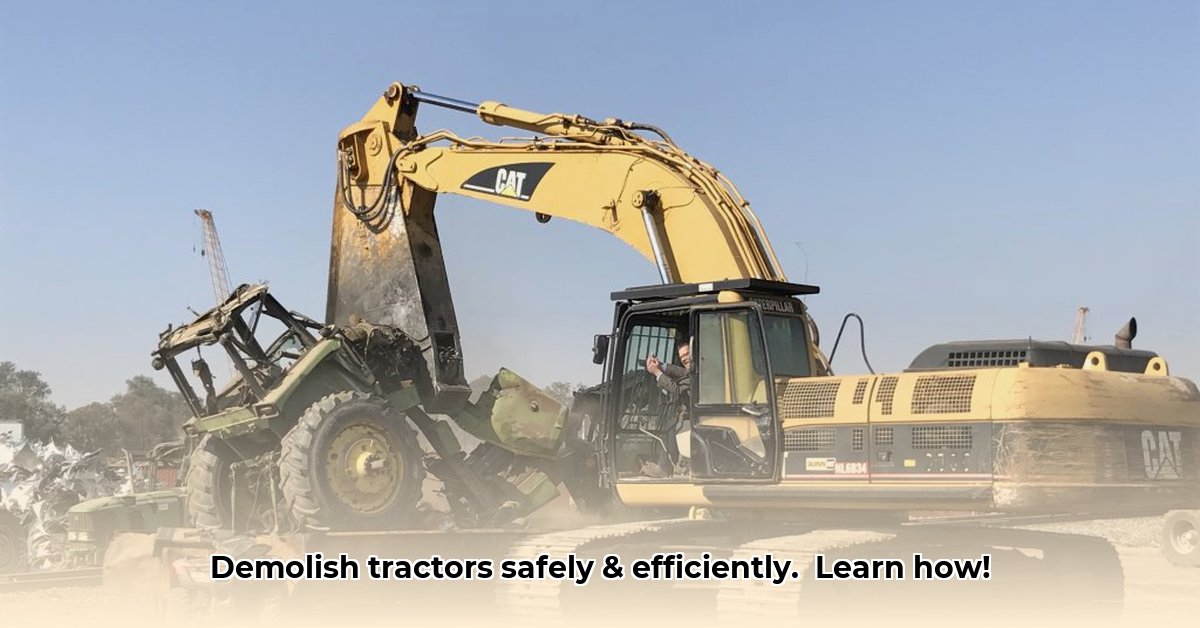
Tractor Demolition: A Comprehensive Guide
Wrecking a tractor demands precision, safety, and a strategic approach. This guide provides a step-by-step process for efficient and responsible tractor demolition, covering equipment selection, safety protocols, and environmental considerations. Understanding these factors is crucial for minimizing costs and maximizing project success.
Equipment Selection: Optimizing Efficiency and Cost-Effectiveness
Choosing the right equipment is paramount for a successful demolition. The ideal choice depends on the tractor's size, condition, and the site's limitations. Let's examine the most common options:
Excavators: Excavators (powerful hydraulic machines with a rotating arm) offer versatility and strength, ideal for larger tractors and precise demolition work. Their long reach allows for maneuvering in various positions, making them efficient for dismantling complex structures. However, their size and operational costs can be prohibitive for smaller projects. Are excavators the most economical option for every demolition project? A careful cost-benefit analysis is necessary.
Bulldozers: Bulldozers (heavy machines with a large blade) are powerful, cost-effective solutions for less intricate demolition tasks. Their strength is perfect for pushing over or breaking down significantly damaged tractors. However, their lack of precision makes them less suitable for scenarios where controlled dismantling is needed. When is a bulldozer the most appropriate choice? When speed and cost-effectiveness are prioritized over precise dismantling.
Skid Steer Loaders with Attachments: Skid steer loaders (small, highly maneuverable machines) offer flexibility with various attachments. Hydraulic shears, crushers, and grapple buckets allow for adaptability to different demolition stages and material types. This versatility makes them adaptable for diverse job sites and tractor conditions. What are the limitations of skid steers compared to excavators or bulldozers? They generally lack the sheer power and reach of their larger counterparts.
Quantifiable Fact: Studies show that choosing the right equipment can reduce demolition time by up to 30%, contributing significantly to overall cost savings.
Safety Procedures: Ensuring a Secure Demolition Environment
Safety is non-negotiable. A thorough risk assessment and adherence to rigorous safety protocols are vital throughout the entire demolition process.
Pre-Demolition Site Survey: A detailed survey is crucial to identify potential hazards like underground utilities, unstable ground, or obstacles. Clearly demarcate danger zones to prevent accidents.
Operator Training & Certification: Only highly trained and certified operators should handle heavy machinery. Proper training minimizes the risk of accidents caused by operator error.
Pre-Operational Equipment Checks: Before operation, perform thorough equipment checks. This includes inspecting hydraulic systems, fuel levels, safety mechanisms, and all other components for correct functioning.
Personal Protective Equipment (PPE): Mandatory PPE includes hard hats, safety glasses, high-visibility clothing, gloves, and steel-toed boots.
Emergency Response Plan: A clear emergency response plan, including emergency contact information and the location of the nearest medical facility, must be readily available and understood by all personnel.
Rhetorical Question: How can we ensure that safety remains the top priority throughout every stage of tractor demolition? By rigorously implementing these safety procedures and fostering a culture of safety consciousness among all personnel.
Step-by-Step Demolition Process: A Structured Approach
The specific steps depend on the equipment and the tractor's condition, but a general outline includes:
Disconnecting Utilities: Safely disconnect all fuel lines, hydraulic lines, and electrical systems before commencement of demolition work.
Partial Dismantling: Start by removing smaller, easily detachable components (tires, seats, lights, etc.). This simplifies the main demolition phase and enhances safety.
Strategic Demolition: Systematically dismantle major components using the chosen equipment. Maintain a methodic approach, prioritizing structural integrity to avoid unexpected collapses.
Material Handling & Disposal: Handle and dispose of all debris according to local regulations. Proper sorting and recycling are essential for environmental responsibility.
Final Site Cleanup: Thoroughly clean and secure the demolition site to ensure its safety for others.
Maintenance and Servicing: Extending Equipment Lifespan
Regular maintenance significantly extends the life of demolition equipment and prevents costly downtime. Adhere to manufacturer's recommended maintenance schedules.
Environmental Considerations: Minimizing Environmental Impact
Responsible demolition incorporates minimizing environmental impact. Control dust using water sprays or barriers. Plan the demolition to reduce noise disruption. Proper waste management and recycling are critical for environmental stewardship.
Expert Quote: "Sustainable demolition practices, such as recycling and waste reduction, are not merely an option; they are a responsibility," says Dr. Emily Carter, PhD, Environmental Engineer at the University of California, Berkeley.
Conclusion: Prioritizing Safety and Efficiency
Successful tractor demolition requires thorough planning, the appropriate equipment, and a rigorous commitment to safety. By following these guidelines, you can ensure a productive, safe, and environmentally responsible project. Remember that responsible demolition goes beyond simply demolishing the tractor; it entails a holistic approach that considers safety, cost-effectiveness and environmental responsibility.